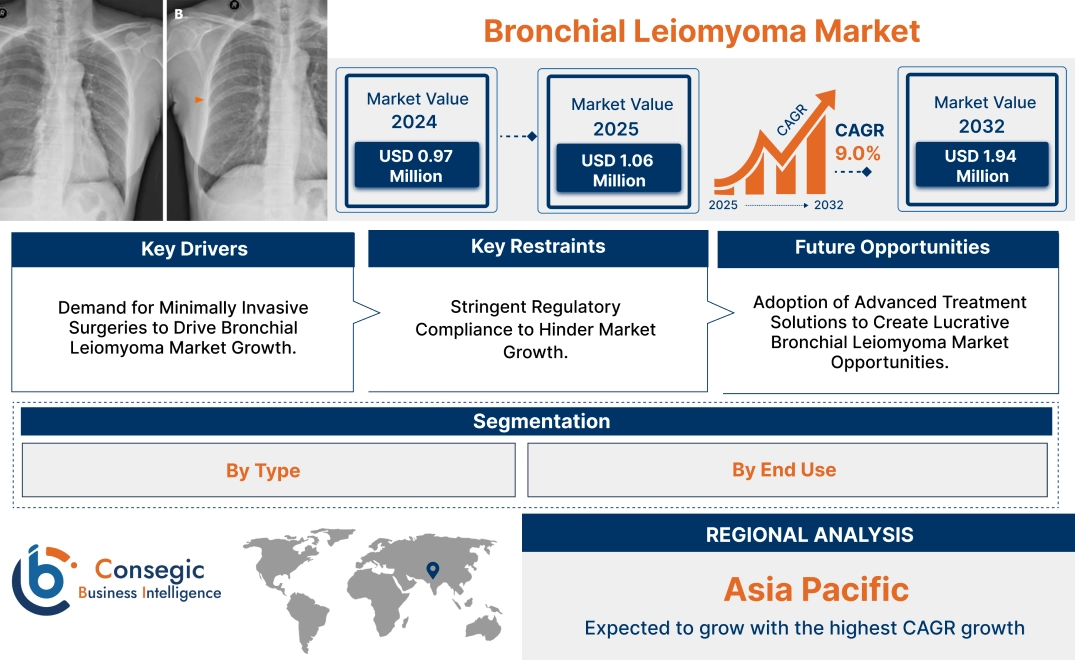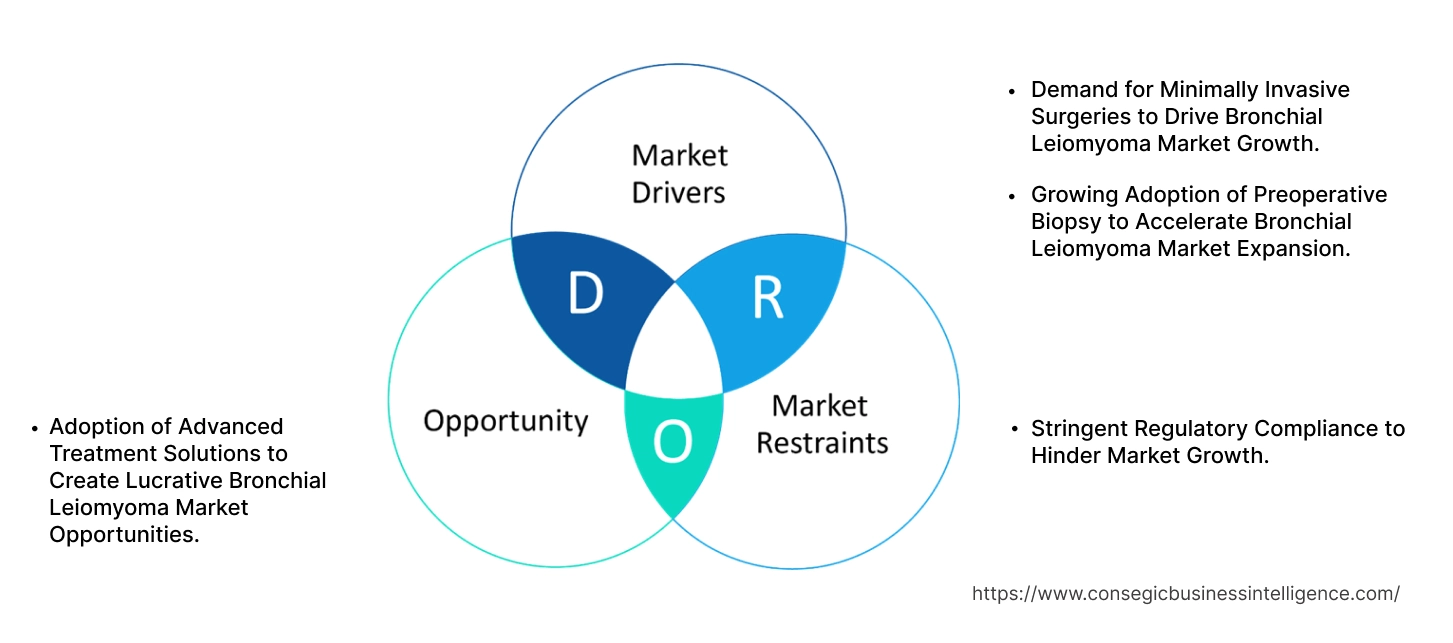- Summary
- Table Of Content
- Methodology
Bronchial Leiomyoma Market Size:
The Bronchial Leiomyoma Market size is growing with a CAGR of 9.0% during the forecast period (2025-2032), and the market is projected to be valued at USD 1.94 Million by 2032 from USD 0.97 Million in 2024. Additionally, the market value for 2025 attributes to USD 1.06 Million.
Bronchial Leiomyoma Market Scope & Overview:
Leiomyomas are a group of benign smooth muscle tumors. Another name for leiomyomas is fibroids. A bronchial leiomyoma is a benign tumor originating from the smooth muscle cells of the bronchial wall. Bronchial obstruction caused by this tumor results in symptoms including cough, wheezing, dyspnea, coughing with blood, and recurrent pneumonia amongst others. The tumor is most commonly diagnosed with CT scans as a homogeneously enhancing airway tumor with intraluminal growth. The treatment for bronchial leiomyoma relies on its location in the airway and the size & width of the lesion. The diagnosis of this condition includes biopsy, imaging, and others whereas treatment mainly involves medications and surgery.
Key Drivers:
Demand for Minimally Invasive Surgeries to Drive Bronchial Leiomyoma Market Growth.
The rise in the adoption of minimally invasive surgeries (MIS) is driving market growth. Minimally invasive surgery is a surgical technique that uses small incisions, tubes, and cameras to perform procedures. Several factors contribute to this demand. The reduced invasiveness of the procedures such as bronchoscopic resection translates to significant benefits for patients. It allows for the removal of smaller, endobronchial leiomyomas without the need for traditional open surgery. In addition to this, MIS results in less post-operative pain, and a much quicker recovery period with less recurrence rate of bronchial leiomyoma.
- For instance, according to the research study published in journal Elsevier, it is stated that the use of minimally invasive surgical resection including bilobectomy offers excellent prognosis.
Thus, shift towards minimally invasive surgery is positively impacting the bronchial leiomyoma market growth.
Growing Adoption of Preoperative Biopsy to Accelerate Bronchial Leiomyoma Market Expansion.
Bronchial leiomyoma mimics other pulmonary conditions, leading to misdiagnosis and potentially inappropriate treatment. A preoperative biopsy aims to obtain a tissue sample before any treatment is performed to confirm the diagnosis of bronchial leiomyoma. A preoperative biopsy, obtained through minimally invasive techniques such as bronchoscopy, allows for a definitive diagnosis of similar appearing pathologies. This is crucial because it reduces the risk of unnecessary surgeries for benign lesions.
- For instance, according to the case study published on NCBI in November 2022, it is observed that use of preoperative biopsy successfully supported definitive histological diagnosis, and plan definitive therapy for bronchial leiomyoma. This resulted in complete preservation of lung parenchyma.
Thus, due to the above-mentioned factors, the use of preoperative biopsy is contributing to bronchial leiomyoma market expansion.
Key Restraints:
Stringent Regulatory Compliance to Hinder Market Growth.
Stringent regulatory standards imposed by government agencies and international organizations worldwide cause barriers in the market. Regulatory bodies such as Food and Drug Administration and European Medicines Agency among others impose long process for approvals. This involves lengthy documentation, product safety assessment, and rigorous quality control procedures for diagnostics and treatment solutions. The regulations present significant constraints for pharmaceutical companies. It leads to increase production costs and slow down product development for diagnostic devices and treatment solutions. Additionally, regulatory authorities and regulatory standards differ by country and region. This creates limitations for researchers and companies operating in multiple jurisdictions. Thus, the impact of these stringent regulations on the bronchial leiomyoma market is multifaceted.
Future Opportunities :
Adoption of Advanced Treatment Solutions to Create Lucrative Bronchial Leiomyoma Market Opportunities.
Adoption of advanced treatment solutions such as robotic assisted surgery is expected to create market trajectory in future years. Robotic surgery offers enhanced precision and dexterity. This potentially improving outcomes in certain cases including bronchial leiomyoma. As the technology evolves and becomes more accessible, its role in bronchial leiomyoma treatment is expected to expand.
- For instance, in For instance, in 2024, New Robotic Bronchoscopy service is introduced at the Glenfield Hospital in the UK. This instrument enhances early diagnosis and treatment of lung cancer. This presents the potential to significantly enhance management of bronchial leiomyoma.
Thus, the use of advanced treatment solutions are creating lucrative opportunities over the forecast period.
Bronchial Leiomyoma Market Segmental Analysis :
By Type:
Based on type, the market is categorized into diagnosis and treatment
Trends in the Type:
- Rising trend of adoption of robotic assisted surgery for greater precision and smaller incisions.
- There is growing research on the development of targeted therapies that control tumor growth.
The treatment segment accounted for the largest market share in 2024 and is expected to grow with the highest CAGR over the forecast period.
- The treatment segment occupies a dominant position in the market. The segment is further categorized into medication and surgery.
- Bronchoscopic resection is a primary procedure adopted for the treatment of this tumor. It is a minimally invasive technique utilizing a flexible bronchoscope.
- Additionally, surgical resection is used for larger tumors, that extend beyond the bronchus. It is an open surgery that involves removal of the tumor and potentially part of the lung.
- Moreover, the availability of advanced treatment technologies such as robotic surgery is supporting the segment expansion.
- For instance, in September 2024, TidalHealth announced the launch of its state-of-the-art robotic bronchoscopy system, designed to improve the diagnosis and treatment of lung diseases in Sussex County. This supports the treatment of overall lung diseases including bronchial leiomyoma.
- Collectively, the aforementioned factors support segment trajectory in the overall bronchial leiomyoma market trend.
By End-Use:
Based on end use, the market is categorized into hospitals, clinics, ambulatory surgical centers, and others.
Trends in the End Use:
- There’s a trend towards outpatient clinics and ambulatory surgical centers for the treatment of bronchial leiomyoma.
- Adoption of telemedicine services for remote diagnosis and management of the condition, especially in rural and underserved areas.
The hospitals segment accounted for the largest market share of 61.44% in 2024
- Hospitals provide expertise, advanced infrastructure, well-established systems amongst others.
- The complex nature of surgical procedures used in bronchial leiomyoma requires advanced equipment for patient care.
- These procedures also necessitate teams that include highly skilled surgeons and other specialists such as nurses and technicians. Hospitals are well equipped to provide these teams.
- Furthermore, hospitals serve as central hubs within established referral networks for patients with bronchial They are also involved in adopting advanced solutions for patient care.
- Additionally, growing healthcare spending is significantly contributing to the provision of effective care through hospital settings.
- For instance, based on the analysis published by the S. Centers for Medicare & Medicaid Services in December 2023, hospital care accounted for a 30% of overall U.S. national healthcare spending in 2022. Spending on hospital care services increased 2.2% in 2022 to reach USD 1.4 trillion.
- Thus, due to the above-mentioned factors, the segment presents a dominant state in the overall bronchial leiomyoma market demand.
The ambulatory surgical centers segment is expected to grow at the fastest CAGR in forecast years.
- The ambulatory surgical center (ASC) end user is expected to occupy growing contribution to the market.
- ASCs have the ability to provide effective and specialized care. They provide surgical procedures in less resource-intensive environments. This allows for quicker recovery and cost-effective solutions for the patient.
- Patients benefit from this setting as it offers minimally invasive surgery. Additionally, these facilities consist of advanced technology and specialized equipment. This helps them to deliver high-quality care and maintain a personalized approach.
- Thus, based on the bronchial leiomyoma market analysis, the aforementioned factors contribute to ambulatory surgical centers as prominent end-users.
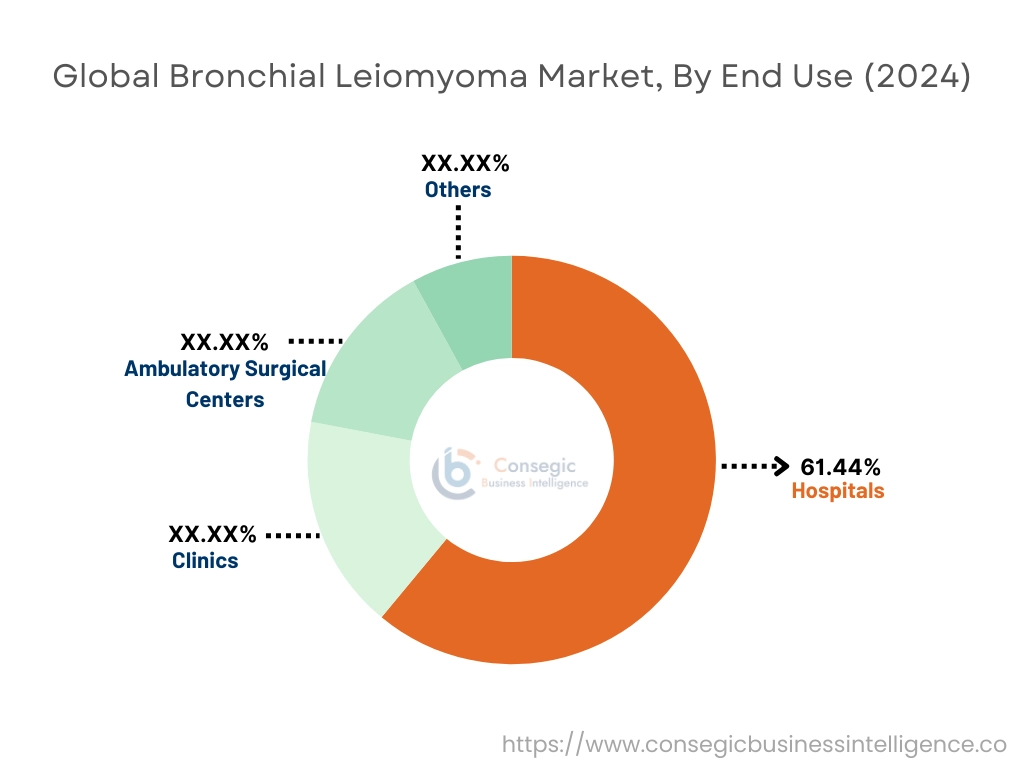
Regional Analysis:
The regional segment includes North America, Europe, Asia Pacific, the Middle East and Africa, and Latin America.
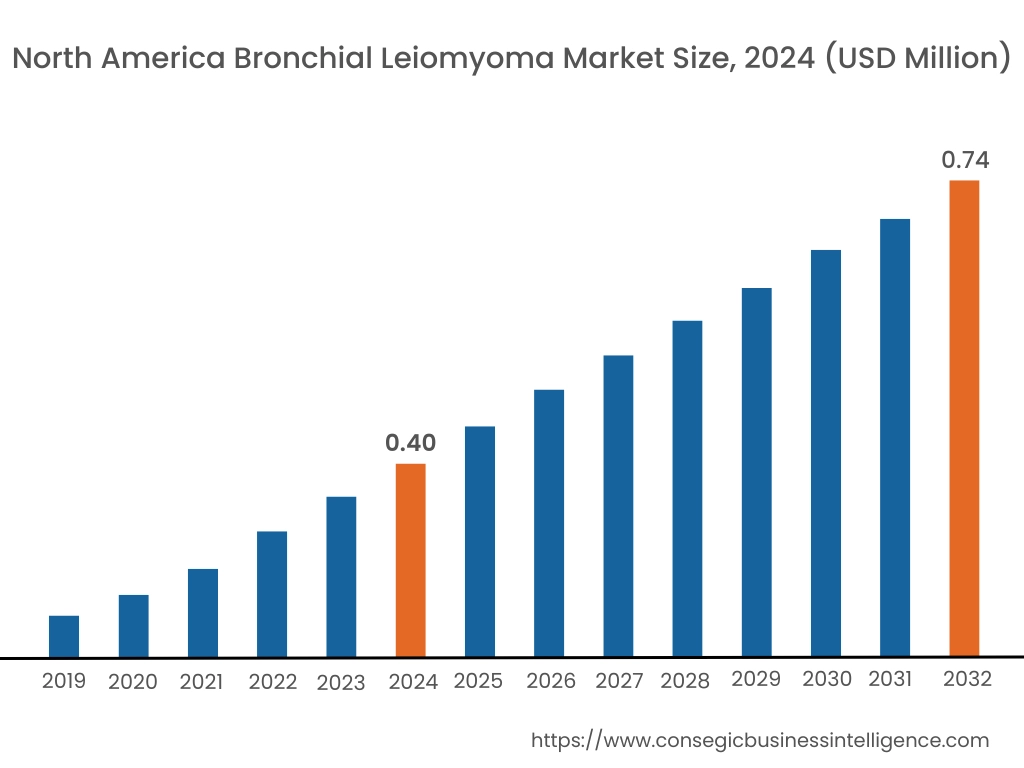
The presence of well-developed healthcare system is the key factor leading to the market trajectory of bronchial leiomyoma in North America. North American countries such as U.S. and Canada present well established healthcare infrastructure. They provide advanced diagnostics such as biopsy, treatment using minimally invasive procedures, and specialized care for bronchial leiomyoma. In addition to this, North America's high healthcare industry expenditure including reimbursement benefits further supports the adoption of these advanced technologies.
- For instance, based on the analysis published by the S. Centers for Medicare & Medicaid Services in December 2024, Medicare spending grew 8.1% to USD 1,029.8 billion in 2023 or 21% of total national healthcare (NHE) spending in the U.S. Medicaid spending grew 7.9% to USD 871.7 billion in 2023 or 18% of total NHE. Medicare provides health coverage for senior citizens, while Medicaid covers health care costs for people with low incomes,
The combination of the aforementioned factors and trends is driving growth in the North American market.
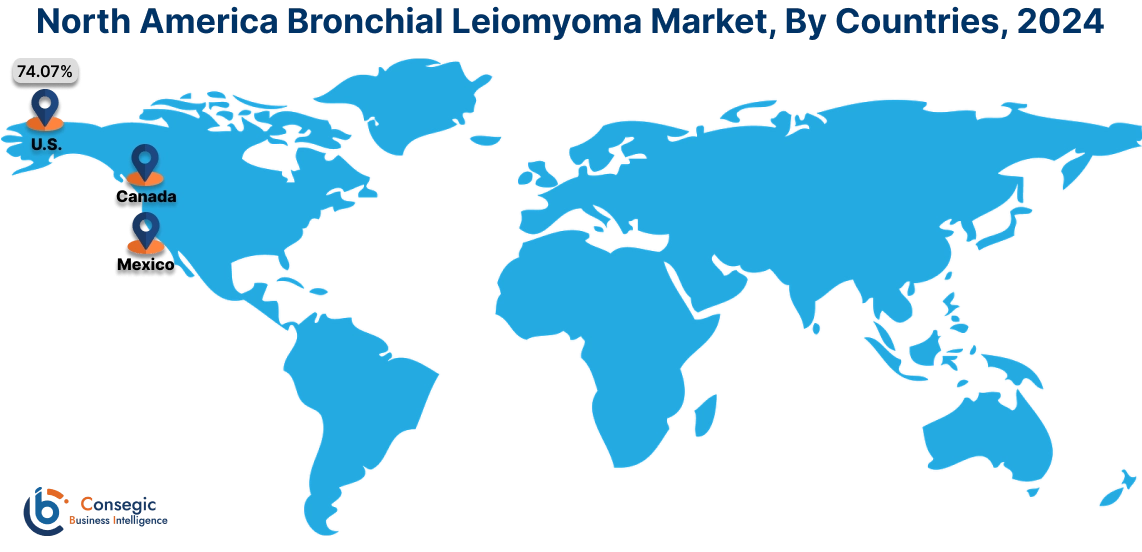
In Asia Pacific the bronchial leiomyoma market analysis is experiencing the fastest growth with a CAGR of 11% over the forecast period. Shift towards the use of telemedicine serves a prominent role in bronchial leiomyoma market demand in the region. Telemedicine and remote monitoring improve access to specialized care for patients in remote areas. Remote monitoring of the condition symptoms enhances patient engagement and allows for timely treatment. This in turn helps in leading to better outcomes. Furthermore, telemedicine reduces travel costs and increases healthcare efficiency. It facilitates collaboration and knowledge sharing among specialists, improving the quality of care and enabling training for local professionals. Owing to these factors, the market in the Asia Pacific is growing at the fastest rate.
Europe makes a significant contribution to market share. The European healthcare industry is mature. This creates a constant need for advanced solutions. Minimally invasive procedures are being prioritized, driven by investments in advanced imaging, robotics, and others. These advancements offer improved patient outcomes, such as reduced infection risk, less post-operative pain, and shorter hospital stays. Additionally, many European countries have strong public healthcare systems that provide access to quality healthcare services, including those for bronchial leiomyoma further propelling the market. Thus, the rise in demand for minimally invasive surgeries is influencing the market trends.
Ongoing advancements in healthcare infrastructure, including enhanced access to healthcare facilities and improved diagnostic capabilities, are contributing to better disease detection and management of bronchial leiomyoma across the Latin America. Increased healthcare expenditure is enabling greater access to healthcare services, including medications and diagnostic tests. Thus, as per analysis, these factors are influencing the share in bronchial leiomyoma market analysis across Latin America.
The Middle East and Africa (MEA) region is witnessing notable share bronchial leiomyoma market trends. The growing healthcare sector in the Middle East is playing a pivotal role in demand. Many countries in the MEA region are investing in developing their healthcare infrastructure with advanced diagnostic and treatment facilities. This includes building hospitals, and clinics, and improving access to diagnostic tools which are essential for detecting this tumor. The combined impact of these factors is creating a favorable environment for the trajectory of the bronchial leiomyoma market opportunities in the MEA region.
Top Key Players and Market Share Insights:
The global Bronchial Leiomyoma Market is highly competitive with major players providing products to the national and international markets. Key players are adopting several strategies in research and development (R&D) and product innovation to hold a strong position in the global Bronchial Leiomyoma market. Key players in the Bronchial Leiomyoma industry include-
- KARL STORZ (Germany)
- Olympus America (U.S.)
- Teleflex Incorporated (U.S.)
- FUJIFILM (Japan)
- Ambu A/S (Denmark)
- Johnson & Johnson MedTech (U.S.)
- Siemens Healthineers (Germany)
- Intuitive Surgical (U.S.)
Bronchial Leiomyoma Market Report Insights :
| Report Attributes | Report Details |
| Study Timeline | 2019-2032 |
| Market Size in 2032 | USD 1,942.31 Thousand |
| CAGR (2025-2032) | 9.0% |
| By Type |
|
| By End Use |
|
| By Region |
|
| Key Players |
|
| North America | U.S. Canada Mexico |
| Europe | U.K. Germany France Spain Italy Russia Benelux Rest of Europe |
| APAC | China South Korea Japan India Australia ASEAN Rest of Asia-Pacific |
| Middle East and Africa | GCC Turkey South Africa Rest of MEA |
| LATAM | Brazil Argentina Chile Rest of LATAM |
| Report Coverage |
|
Key Questions Answered in the Report
How big is the Bronchial Leiomyoma market? +
In 2024, the Bronchial Leiomyoma market is USD 977.96 Thousand.
Which is the fastest-growing region in the Bronchial Leiomyoma market? +
Asia Pacific is the fastest-growing region in the Bronchial Leiomyoma market.
What specific segmentation details are covered in the Bronchial Leiomyoma market? +
By Type and End Use segmentation details are covered in the Bronchial Leiomyoma market.
Who are the major players in the Bronchial Leiomyoma market? +
KARL STORZ (Germany), Olympus America (U.S.), Ambu A/S (Denmark), Johnson & Johnson MedTech (U.S.) are some of the major players in the market.
